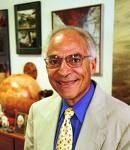
Dr. Farouk Elbaz
Professor and Director of the Center for Remote Sensing at Boston University.
Biography:
He received a B.Sc. degree (1958) in chemistry and geology from Ain Shams University, Cairo, Egypt; an M.S. degree (1961) in geology from the Missouri School of Mines and Metallurgy, Rulla, Missouri; and a Ph.D. degree (1964) in geology from the University of Missouri, after performing research at the Massachusetts Institute of Technology, Cambridge, Massachusetts (1962-63). He taught geology at Assiut University, Egypt (1958-60), and the University of Heidelberg, Germany (1964-1966). In 1989, he received an honorary Doctor of Science degree from New England College, Henniker, New Hampshire.
He participated in the Apollo program from 1967 to 1972 as Supervisor of Lunar Science Planning at Bellcomm, Inc. of Bell Telephone Laboratories, Washington, D.C. During these six years, he was Secretary of the Site Selection Committee for the Apollo lunar landings, Chairman of the Astronaut Training Group, and Principal Investigator for Visual Observations and Photography. Beginning in 1973, and for the next ten years, he established and directed the Center for Earth and Planetary Studies at the National Air and Space Museum, Smithsonian Institution, Washington, D.C. In 1975, he was selected by NASA as Principal Investigator for Earth Observations and Photography on the Apollo-Soyuz Test Project, the first joint American-Soviet space mission. From 1982 to 1986, he was Vice President for International Development and for Science and Technology at Itek Optical Systems of Lexington, Massachusetts.
Dr. El-Baz served on the Steering Committee of Earth Sciences of the Smithsonian Institution, the Arid and Semi-Arid Research Needs Panel of the National Science Foundation, the Advisory Committee on Extraterrestrial Features of the U.S. Board of Geographic Names, and the Lunar Nomenclature Group of the International Astronomical Union. In 1979, after the United States and China had normalized relations, he conducted the first visit by U.S. scientists to the desert regions of northwestern China. In 1985, he was elected Fellow of the Third World Academy of Sciences and represents the Academy at the Non-Governmental Organizations Unit of the Economic and Social Council of the United Nations. He also served as Science Advisor (1978-1981) to the late Anwar Sadat, President of Egypt.
He is known for pioneering work in the applications of space photography to the understanding of arid terrain, particularly the location of ground-water resources. Based on the analysis of space photographs, his recommendations resulted in the finding of ground-water resources in the Sinai Peninsula, the Western Desert of Egypt and in arid terrains in northern Somalia and the Red Sea province of Eastern Sudan. Furthermore, during the past 20 years, he contributed to interdisciplinary field investigations in all major deserts of the world.
Presentation Abstract:
WOMEN IN SPACE SCIENCE: Hypatia may have started it all, right here in Alexandria. She was a distinguished scientist among the giants of 5th Century Egypt under the Romans. Her contributions to mathematics and astronomy assured placement of her name on a lunar crater, an honor reserved only to the most distinguished of scientists. Since then, women astronomers and physicists have proven their ability to excel in every research field. Each team that made tangible contributions to our understanding of the universe included women. In general, they did not get their fair share of prizes and accolades, because these women were team members and not leaders. However, this should not detract from the significance of their contributions.
In my own field of the analysis of satellite images - to interpret the origin of planetary landforms and to decipher the stages of their evolution in space and time - women perform even better than men. Naturally, I am very selective in hiring individuals with superior abilities to classify and describe what is depicted in space images. It turns out that, on average, women make 80% of my team members. To me, this is due to the facts that women have: (a) more patience to deal with mundane, but necessary tasks; (b) better intuition, to recognize and propose reasons; and (c) higher degrees of intellectual courage, to suggest ideas without fear of being mistaken. Therefore, it is imperative that we encourage and better train women in all sciences that require these special attributes. In so doing, we can assure better utilization of the special qualities of our citizens for the sake of human progress.
Status: Confirmed